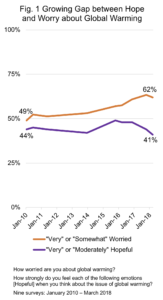Climate Note · Oct 9, 2018
Americans are More Worried about Global Warming, and Show Signs of Losing Hope
By Matthew Ballew, Jennifer Marlon, Edward Maibach, Abel Gustafson, Matthew Goldberg and Anthony Leiserowitz
Filed under: Beliefs & Attitudes, Policy & Politics and Behaviors & Actions

With weather becoming more extreme—including powerful hurricanes, stronger droughts and heatwaves, and increased flooding due to sea-level rise—more Americans are personally experiencing the effects of climate change. It is, therefore, no surprise that this increase in danger is accompanied by an increase in worry about global warming. In our recent nationally representative survey of American adults, more than six in ten said they were “very” or “somewhat” worried about global warming, whereas fewer than half did in 2010.
In contrast, our data show that American’s feelings of hope about global warming have declined over the past two years—diverging from worry. In 2010, the number of Americans expressing hope was similar to that of worry: about 44% of the U.S. population said they were “very” or “moderately” hopeful when thinking about global warming. During the final years of the Obama Administration (from 2014 to 2016) and the signing of the 2016 Paris Climate Agreement, there was an uptick in both hope and worry. However, from 2017 onward—coinciding with the Trump Administration—Americans became more worried and less hopeful about global warming.
Research indicates that worry and hope motivate constructive engagement with global warming. In a 2014 study conducted by Dr. Nicholas Smith, a social and environmental psychologist at the University of Westminster, and Dr. Anthony Leiserowitz, Director of the Yale Program on Climate Change Communication, the emotions of worry and hope were among the strongest predictors of public support for climate change policy.
The increase in worry may be motivating some Americans to act on global warming. Still, remaining hopeful is also important to spur engagement. Data from our latest 2018 nationally representative survey show that Americans who remain hopeful are consistently more likely than those with less hope to say they will act on global warming, including contacting a government official, donating and volunteering to environmental organizations, and joining a campaign to convince elected officials to take action. Hopeful Americans are also more likely to discuss global warming with their friends and family and support policies to reduce global warming, such as regulating CO2 (the primary greenhouse gas) as a pollutant, requiring utilities to use more renewable energy (e.g., solar, wind power), and funding more research into renewable energy.

Although global warming is one of the world’s most serious threats to humans and other species there are many reasons to remain hopeful about reducing global warming. Our 2018 research on American public opinion reveals several key reasons:
- Most Americans support diverse policies to reduce global warming. For example, 85% of Americans support funding more research into renewable energy, 77% support regulating CO2 as a pollutant, 70% support setting strict CO2 limits on existing coal-fired power plants, and 68% support requiring fossil fuel companies to pay a carbon tax.
- Most Americans (70%) think environmental protection is more important than economic growth when there is a conflict between the two.
- Americans across the country overwhelmingly support teaching climate science in schools: about 79% agree that schools should teach children about the causes, consequences, and potential solutions to global warming (even in conservative states).
Beyond public opinion on global warming, many individuals, organizations, and institutions in the United States are joining the fight against global warming.
For instance:
- Institutions across the U.S. are upholding the 2016 Paris Climate Agreement to reduce heat-trapping carbon pollution (see We Are Still In). So far, 10 states, 280 cities and counties, 344 colleges and universities, and over 2,000 businesses and investors have pledged to join the global pact to reduce global warming.
- About half of Fortune 500 companies have committed to at least one climate or clean energy goal, according to a 2017 Worldwide Wildlife Foundation report. In fact, Fortune 100 companies are leading the way, as 63% have set one or more clean energy goals. Together, the annual reductions in greenhouse gas emissions from companies is comparable to 45 coal-fired power plants going off the grid for one year.
- The clean energy industry is flourishing. The 2018 E2 Clean Jobs America Report shows that about 3.2 million Americans are employed in the clean energy industry, such as solar, wind, energy efficiency, and clean vehicles. The solar industry alone employs about four times more workers than the coal industry, and the energy efficiency industry (including contractors who perform building and home upgrades) employs twice as many people as the entire fossil fuel industry.
What can every American do to keep hope alive? All of us can take action by discussing global warming with our friends and family, changing our consumer choices (e.g., making clean energy with solar panels, or buying clean energy from our utility company or a third party provider), contacting our government officials to urge them to act on global warming, and making clear to candidates that our votes can be earned by those pledging to enact climate change policies. For more information on how to act on global warming, check out this list of resources.
Survey Method
The data in this report are based on nine nationally representative surveys conducted in the United States in January 2010, June 2010, May 2011, December 2013, October 2015, March 2016, November 2016, October 2017, and March 2018. Surveys were conducted using GfK’s KnowledgePanel®, an online panel of U.S. adults (18+). All questionnaires were self-administered by respondents in a web-based environment.
For more information on when the surveys were conducted and the sample sizes of each wave, please review the end of the 2018 Climate Change in the American Mind report.
